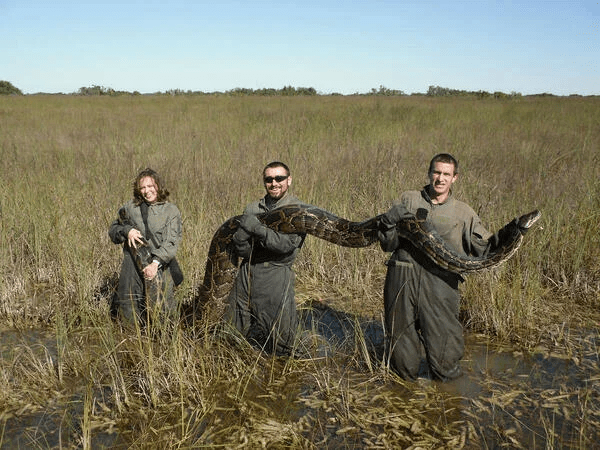The Burmese Python, a threat to the American ecosystem, deserves attention as a true star among snakes, a titan competing with the anaconda for the title of largest legless reptile, and a conqueror of new continents.

What do you mean the Burmese Python is a threat to America?! The python’s homeland is on a completely different continent! It inhabits India and a little bit of Southeast Asia, on the exact opposite side of the Pacific Ocean. It couldn’t possibly end up in the US… until the Americans decided that the Burmese Python was a wonderful pet!

After growing to 4-5 meters and eating 40-50 kilos, domestic snakes quickly gained their freedom and were released into the wild by their former owners across all states in the US, causing panic. In Florida, the reptiles mistook the local jungle for their native home. As a result, the population of Burmese Pythons in America has become stable at 30,000 individuals since 2008.

The fauna of the southern state was defenseless as the Burmese Pythons, already at the top of the food chain in India, found themselves in Florida where they had access to a buffet table. The snakes quickly integrated themselves into the local ecosystem, disrupting food chains that had been established for millennia and living a luxurious life amidst the local residents.

In Everglades National Park, the situation turned out to be so terrible that Burmese Pythons wiped out 99% of the opossums, raccoons, and rabbits. The eradication of the prey also led to the disappearance of predators such as coyotes, lynx, and even pumas. All of Florida’s carnivorous mammals were on the brink of starvation. The only creature that did not yield to the invader was the alligator, which periodically exchanged courtesies with the python by eating them.

Thanks to a combination of strength, size, and cunning tactics, the Burmese Python was able to turn the entire ecosystem upside down. With its skilled camouflage, the python would quietly lie in a layer of bedding and wait for careless warm-blooded animals that were just asking to be eaten. When the time was right, it would jump out of hiding, grab the juicy prey with its teeth, and give a deadly hug. After that, the lifeless body would go straight into the snake’s mouth.

Frosts have hindered the further expansion of Burmese Pythons as they are not accustomed to the cold and simply cannot survive beyond the resort’s 26 °C. However, in 2018, researchers discovered that pythons are slowly adapting to winter at the genetic level. They found genes in the snakes’ DNA that promote an increased metabolism, making the organism more adapted to cold temperatures. The higher the metabolism rate, the better the snake can cope with the cold climate.

Burmese Pythons have also adapted their behavior to cope with the cold temperatures. In winter, when the temperature drops to +12°C (!), the reptiles hibernate in a secluded corner, such as a hole or burrow. But after the “freezing” period, it’s time for warmth and love. Despite being cold-blooded, pythons are not cold-hearted towards their partners and offspring.

During March-April, Burmese Pythons go on dates, where the male and female spend hours together. After intertwining their destinies (and bodies), the female reptile lays a clutch of 15-30 eggs. The mother-to-be wraps the eggs in a circle and actively contracts her muscles to maintain a temperature slightly higher than the surrounding environment. Snakelets spend 2-3 months in the mother’s embrace before they are ready to fend for themselves. Afterward, the newborn offspring are immediately capable of hunting, defending themselves, and dominating the surrounding fauna.
Related posts:
- Cold-Induced Allergies: Myth or Reality?
- Investing in video games: evaluating the industry and promising companies
- Demystifying MMA: Exploring the Abbreviations and Rules of a Riveting Combat Sport
- Tips for safeguarding your skin against sun damage
- The Future of Deep-Sea Mining: Risks and Rewards
- The Benefits and Risks of Living with Pets: Understanding Zoonotic Diseases

Responses